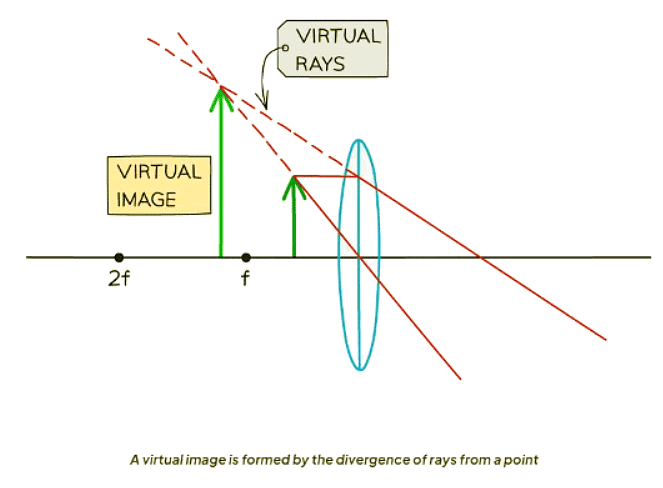Class 10 Exam > Class 10 Notes > Physics for GCSE/IGCSE > Uses of Lenses
Uses of Lenses | Physics for GCSE/IGCSE - Class 10 PDF Download
Magnifying Glasses
- If the object is placed closer to the lens than the focal length, the emerging rays diverge and a real image is no longer formed
- When viewed from the right-hand side of the lens, the emerging rays appear to come from a point on the left. This point can be found by extending the rays backwards (creating virtual rays).
- This point can be found by extending the rays backwards (creating virtual rays).
- A virtual image will be seen at the point where these virtual rays cross.

- In this scenario, the resulting image is virtual, enlarged, and upright.
- Virtual
- Enlarged
- Upright
- Utilizing a lens in this manner enables it to function as a magnifying glass.
- When employing a magnifying glass, it is essential to hold the lens close to the object.
Question for Uses of LensesTry yourself: What happens to the emerging rays when an object is placed closer to the lens than the focal length?View Solution
Correcting Sight
Converging and diverging lenses are frequently employed in eyeglasses to address vision impairments.
- Converging lenses are suitable for correcting long-sightedness.
- Diverging lenses are effective in rectifying short-sightedness.
Correcting Short-Sightedness
- Short-sighted individuals have eyes that are considered "too large."
- Consequently, they struggle to see distant objects clearly and can only perceive nearby objects.
- This condition arises because the eye refracts light, focusing it before it reaches the retina, which is positioned at the back of the eye.
- In essence, the focal point falls in front of the retina.
- Correction is achieved by employing a concave or diverging lens.
Correcting Long-Sightedness
- Long-sighted individuals have eyes that are deemed "too small."
- As a result, they experience difficulty in clearly seeing close objects and primarily have clear vision of distant objects.
- This occurs because the eye refracts light rays, focusing them beyond the retina at the back of the eye.
- Essentially, the focal point lies behind the retina.
- Correction can be attained by using a convex or converging lens.
The document Uses of Lenses | Physics for GCSE/IGCSE - Class 10 is a part of the Class 10 Course Physics for GCSE/IGCSE.
All you need of Class 10 at this link: Class 10
|
126 videos|194 docs|35 tests
|
FAQs on Uses of Lenses - Physics for GCSE/IGCSE - Class 10
| 1. How do magnifying glasses correct sight? |  |
Ans. Magnifying glasses work by enlarging the image of an object, making it easier for the eyes to see details more clearly. This can help improve vision for individuals with difficulty seeing small print or objects up close.
| 2. What are the different types of lenses used in magnifying glasses? |  |
Ans. The most common types of lenses used in magnifying glasses are convex lenses, which are thicker in the center and thinner at the edges. These lenses bend light rays to converge at a focal point, magnifying the image.
| 3. Can magnifying glasses be used to improve vision for people with visual impairments? |  |
Ans. Yes, magnifying glasses can be used to help individuals with visual impairments by magnifying objects and text, making them easier to see. However, it is important to consult with an eye care professional for proper diagnosis and treatment.
| 4. How do magnifying glasses differ from prescription glasses for correcting vision? |  |
Ans. Magnifying glasses are typically used for temporary or occasional use to magnify objects or text, while prescription glasses are custom-made to correct specific vision problems such as nearsightedness or farsightedness.
| 5. Are there any specific guidelines for selecting the right magnifying glass for a particular task? |  |
Ans. When choosing a magnifying glass, consider factors such as the magnification power, lens size, and type of lighting needed for the task. It is recommended to test different magnifying glasses to find the one that works best for your specific needs.
Related Searches















